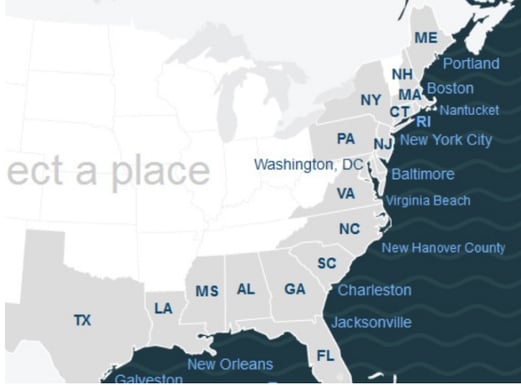I fell asleep to a TED Talk while visiting New York City the other night, but a startling statement brought me back to consciousness. New studies predict the oceans could rise by close to two meters (more than six feet) by the end of the century. That’s double original estimates and only 83 years from now - in our kids’ or at least our grandkids’ lifetimes!
Past predictions had suggested that seas could rise by just under a meter at most by the year 2100. Those estimates relied on the notion that expanding ocean waters and the melting of relatively small glaciers would fuel the majority of sea level rise, rather than the massive ice sheets of Greenland and Antarctica. Turns out nobody included the melting icecaps of Antarctica in earlier calculations!
I think the statement struck home that night since I had traveled the NYC subways all day and had thought about the meaning of resiliency for this particular city. I am also sensitive to rising waters after Hurricane Irene threatened my own home and destroyed many homes of my friends and neighbors a few years ago. This reduced timeframe of a significant impact on my world within my children’s lifetime has taken me aback.
The Meaning of Resiliency
“Resilience is the ability of a system or community to survive disruption and to anticipate, adapt, and flourish in the face of change. The important components of this are that it incorporates both short-term disruption and long-term trends.”
As many as 3.7 million U.S. residents in 2,150 coastal areas of our eastern coastline are now affected by storm surges. On top of that, according to Steven Nerem of the University of Colorado in 2015, we are "locked into at least 3 feet of sea level rise, and probably more." Every state along our country’s perimeter – east and west - will be affected with a 6-foot rise in sea level. To put this in context, about 500,000 people live on the 120 square miles of land that lie less than 6 feet above the mean high tide line in the state of New York. More than $100 billion in property value exists in that area alone.

Flood – Rebuild – Repeat
The definition of resiliency incorporates both short term disruptions and long term trends. “Short-term disruptions,” like hurricanes Katrina, Irene, and Sandy, are storms where water levels return to normal within hours or days. My personal experience with Hurricane Irene saw water levels up to the stop sign at my street corner at 6:30 am, but we could drive the road by 3:30 pm. I equate this to stepping on an ant hill – it’s a devastation that sends all the ants scrambling to rebuild, but life quickly resumes and the calamity is forgotten.
Researchers at MIT and Princeton University have found that the types of superstorms that used to make landfall once a century could now arrive every three to 20 years, and that so-called “500-year floods” might arrive as often as every 25 years, according to findings published in Nature Climate Change.
The National Flood Insurance Program (NFIP) has records of 30,000 most frequently flooded properties, called Sever Repetitive Loss Properties, that represent 0.60% of the 5 million homes in the program. These properties have received 10.6% ($5.5 billion dollars) of all flood insurance claims since 1978 and the vast majority of properties have not taken steps to protect against future floods, like putting their home on stilts or pilings or relocating to higher ground.
City Infrastructure
In addition to individual homeowners, I’m thinking about the cost of resilient city infrastructure. Since 2008, the New York Department of Environmental Protection has been investigating the impacts of climate change on its infrastructure of wastewater facilities, and for drinking water supply and stormwater management. The study determined that all 14 wastewater treatment plants and 60 percent of pumping stations are at risk of flood damage in New York City.
.jpg?width=556&name=11._Station_Being_Pumped_out_(8152151223).jpg)
Moreover, with about 20 million people living, working and commuting in its 31 counties, the New York City metropolitan area is home to the largest public transportation system in the US. Without this system, New York City cannot function. With a 4-foot rise in sea level, storm-related flooding would inundate much of Manhattan’s subways, including almost all of the tunnels crossing into the Bronx beneath the Harlem River and the tunnels under the East River. Despite the storm’s weakened state when it arrived in New York, as well as extensive efforts by the MTA to protect the tunnels, water still came within inches of flooding parts of the subway system in Lower Manhattan during Hurricane Irene and one year later nine subway stations were flooded during Hurricane Sandy.
It’s a daunting task, but in 2013 New York City did produce a comprehensive plan that contains actionable recommendations both for rebuilding the communities impacted by Sandy and increasing the resilience of infrastructure and buildings citywide. A 2016 report states that the City is implementing the $20 billion OneNYC resiliency program to rebuild and reduce the risks that a changing climate poses to New Yorkers. The City is advancing a multi-layered strategy, including planning and policy studies, legislative actions, and investments in buildings, critical infrastructure, and coastal protection projects.
A daunting task indeed. One, I certainly hope, of which we will not lose sight. Sea levels are going to rise slowly over the next 83 years. How long will it be before it rises enough to cripple the economic powers of New York City…and Baltimore…and Miami…and Washington D.C…..and San Francisco?


